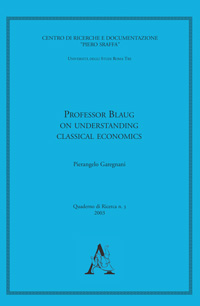Professor Blaug on Understanding Classical Economics
Area 13 – Scienze economiche e statistiche
Tweet
SINTESI
In Blaug’s view, the interpretation he labels as “Sraffian” considers the classical economists through the “distorting lenses” of “linear models of production” and overlooks the central importance those authors gave to institutional and political elements. This view appears however to be founded on a misreading. Unlike what Blaug supposes, that interpretation does not take outputs and real wages as ultimate data, but only as what we may describe as “intermediate” data: they are determined, that is, prior to, and separately from, the non–wage distributive variables which are then obtained as the difference or surplus of a given output over the given subsistence–based wages (and means of production) consumed in its production. By ignoring that prior classical determination, Blaug in fact neatly excises from the interpretation he is criticising the very institutional and political factors which he, then, unsurprisingly finds missing, and which are those playing the dominant role in the (separate) determination of wages and outputs. Blaug’s detailed criticisms are shown to confirm that basic misreading. It is further pointed out how the “Canonical” interpretation of classical wages which Blaug shares with Samuelson and other interpreters, and to which he essentially refers in his article, appears to beg the question of the demand and supply distributive mechanism it attempts to trace in Smith and Ricardo. It does so when it has to introduce a neoclassical type of elastic labour demand function to trigger off the wage changes destined to balance the growths of labour and capital — a process which in those classical writers is instead based, we argue, on the varying pressure of labour underemployment (“redundant population”) implied in what they often describe as the “proportion of the demand to the supply of labour”, two single quantities and not the modern functions which go by that expression. Blaug’s contradictory rejection of the “Sraffian interpretation” — key elements of which, like the so called “corn model” or the recognition of permanent labour unemployment by classical authors, he has long shared — are then traced to his difficulty in conceiving the possibility of a theoretical paradigm alternative to the dominant one, such as it existed in the old classical economists before the drastic break in theoretical continuity which occurred after Ricardo’s death.
| pagine: | 40 |
| formato: | 17 x 24 |
| ISBN: | 978-88-7999-530-6 |
| data pubblicazione: | Settembre 2004 |
| marchio editoriale: | Aracne |
| collana: | Centro di Ricerche e Documentazione “Piero Sraffa” dell’Università degli Studi Roma Tre | 3 |

SINTESI













